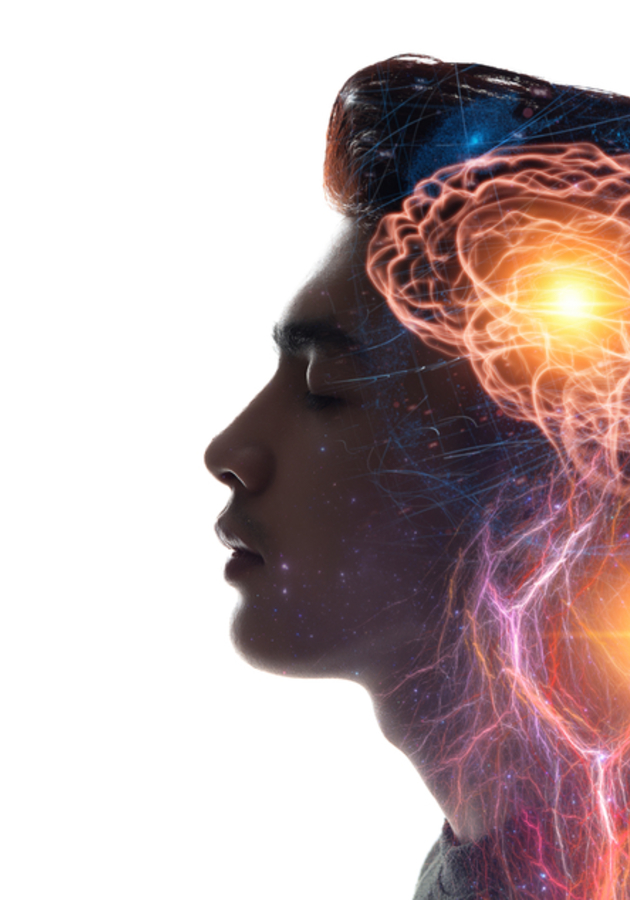When was the last time your doctor reminded you to take good care of your brain? Probably never, unless you count the advice to wear a helmet while riding a bike. And yet, health-wise, it is probably the most important part of your body, the one organ that rules them all. To quote American neurosurgeon Sanjay Gupta: “Your heart ticks, yes, but it’s your brain that ultimately makes you tick and determines your quality of life. Without a healthy brain, you cannot even make healthy decisions. And with a healthy brain comes not only a healthy body, weight, heart, and so on, but also a stronger sense of confidence, a more solid financial future thanks to smart decisions, better relationships, more love in your life, and heightened overall happiness.”
Not solely because of this, in his 2021 bestseller “Keep Sharp,” Gupta puts the brain first. Combining decades of experience with cutting-edge insights from top scientists from all over the world, the book aims to help you build a more resilient and healthier brain, better able to connect patterns and capable of toggling back and forth between short-term and long-term views of the world. To this end, Gupta dedicates the bulk of his book to debunking the 12 most pervasive myths about the aging brain and examining the five pillars of brain health. To put things another way, get ready for 17 brief chapters that will help you understand your brain better and teach you how to keep it young and healthy, regardless of your age!
Myth No. 1: The brain remains a complete mystery
American biologist E. O. Wilson, justly nicknamed “Darwin’s natural heir,” once wrote that “the human brain is the most complex object known in the universe – known, that is, to itself.” Indeed, we often tend to forget that the 3-pound spongy mass of fat and protein encased in our skulls has produced every single thought, feeling, memory, action and experience in the history of humankind – including the ones we use to describe and define it. Put simply, we can only use the brain to study the brain. That certainly gives this incredible organ some mystical quality. However, it doesn’t make it impenetrable.
In fact, we know a lot more about the brain’s structure and functions today than the internet would have you believe. “While there is still a lot to learn,” explains Gupta, “researchers have recently made great strides in understanding the brain. We know more about the connections between different parts of the brain and their relevance to how we think, move, and feel. We are better able to anatomically identify the areas of the brain responsible for depression, obsessive compulsive disorder, and addiction. And we can better rehabilitate the brain after injury or stroke.” And as time goes by, we will only get better at everything. So, while it may be true that the brain is more mysterious than other organs, it’s not a complete mystery. It hasn’t been for a while.
Myth No. 2: Older people are doomed to forget things
Of course, it’s a matter of fact that some cognitive skills decline with age “especially if you don’t employ strategies to pay closer attention and help you remember.” But it’s also true that other cognitive skills improve as you get older.
For example, whereas “the younger you” may have been better at picking up a new language, “the older you” will certainly be superior with vocabulary use. Just as well, the older you will probably be a better judge of character and score unambiguously higher on tests of social communication and diplomacy. Perhaps more importantly, as we age, we tend to improve at controlling our own emotions and weathering stress.
In other words, we don’t really know if your IQ decreases with age: the tests are too faulty to be conclusive. However, we’re absolutely certain that your EQ increases. George Bernard Shaw was wrong to say that youth is wasted on the young. In more ways than one, our brains are actually younger in old age.
Myth No. 3: Dementia is an inevitable consequence to aging
As defined by most encyclopedias, dementia is a set of related symptoms of impairment in memory, thinking and social abilities that are caused by a brain injury or disease. The last part is of vital importance: dementia is neither natural nor unavoidable. “Dementia is not a normal part of aging,” explains Gupta. “Typical age-related changes in the brain are not the same as changes that are caused by disease. The former can be slowed down and the latter can be avoided.” We’ll get to that later.
Myth No. 4: Older people can’t learn new things
According to the newest research, neurogenesis – that is, the creation of new neurons in the brain and their integration into neural circuits – can occur even in late old age in humans. This, especially when combined with the fact that older people aren’t doomed to forget things, means that “learning can happen at any age, especially when you get involved with cognitively stimulating activities like meeting new people or trying new hobbies.” True, some things – such as learning a second language – may take longer for an older person, but “longer” doesn’t mean “impossible” or “of lower quality.” Even people diagnosed with Alzheimer’s disease have been shown to be able to learn new things. So, never say “never.”
Myth No. 5: You must master one language before learning another
No scientific study has ever shown that the brains of children are wired to learn only one language. On the contrary, many studies have demonstrated that children who learn two languages simultaneously (or simultaneous bilinguals) go pretty much through the same processes as children who learn a first language followed by a second language (sequential bilinguals). Evidence is inconclusive whether simultaneous bilinguals progress at the same rate as sequential bilinguals, but once again “longer” doesn’t mean “impossible” or “worse.” On the contrary, in this case, it means better: simultaneous bilinguals have been shown to acquire “a better generalized knowledge of language structure as a whole.”
Myth No. 6: A person who has memory training never forgets
As complex as it is and as mystical as it might seem, our brain is still just another organ. Consequently, some of the rules that apply to other organs, apply to our brain as well. One of them – perhaps the most important of them all – is “use it or lose it.” No matter how rigorously and dedicatedly you may exercise in your 20s, there’s no chance you’ll have a good and healthy body in your 60s, unless you keep yourself fit in the meantime. The same holds true for your memory. Unless you train it constantly, you’ll become forgetful. Neurons wire only when – and if – they are made to fire. Otherwise, they fall asleep and break the circuit.
Myth No. 7: We use only 10% of our brains
This is, perhaps, the most pervasive brain myth of them all. Popularized by the self-help movement of the 1920s, it likely originated in a misunderstanding of a plausible claim made by Harvard psychologist William James – namely, that people meet only a fraction of their full mental potential. However, there’s a difference between not meeting your full mental potential and not using 90% of your brain. The truth is that your brain uses pretty much all of its 86 billion neurons, which is why almost any type of brain damage is worrisome and may increase an adult’s risk of developing dementia at some point in life.
That being said, there’s some truth that parts of our brains are more important than other parts in performing certain functions. That’s why some brain injuries can have profound consequences for language or sensory perception, while affecting few other things. “I think of the brain like a town,” explains Gupta. “The important structures such as the homes and shops are in nearly constant use, and they probably represent 10% to 20% of our brains. The rest, however, are the roads that connect all these shops and homes. Without the roads, information could not get where it needs to go. So, while the roads are not in constant use, they are necessary.”
Myth No. 8: Male and female brains differ in ways that dictate intelligence
Males and females differ in several aspects of their brains, most notably in their size: on average, men have between 8% and 13% larger brains than women. However, that doesn’t mean that men are more intelligent than women or even “better equipped” to perform cognitive operations. It means even less that men are “biologically better suited for math and science, whereas women are better suited for empathy and intuition.” As Gupta writes, “some of the worst-designed, least reproducible, and most biased research in the history of science claims to provide biological explanations for differences between the sexes.”
The truth is that scientists have just begun to objectively study the differences between the brains of men and women, and so far, they have discovered just merely a few sex-related differences in cognition and reasoning, neither of them worthy of particular note. However, they’ve also discovered one difference that is: for some reason, women are more likely to develop Alzheimer’s disease in old age than men. That reason might have to do with the hormonal changes in pregnancy, as the number of pregnancies has been shown to be a risk factor for Alzheimer’s disease. But even that correlation is considered speculative at present.
Myth No. 9: A crossword puzzle a day can keep the doctor away
There is some – but only some – truth to this myth. Case in point, a 2019 follow-up study by the University of Exeter Medical School and King’s College London “confirmed earlier results that showed the more often participants engaged with puzzles, the better they performed on tasks assessing attention, reasoning, and memory.” So yes, when it comes to brain health, there is value in doing crossword puzzles. However, be aware that they flex only a portion of your brain – namely, its word finding ability (also called fluency). If you want to keep your brain sharp in a more general, overall sense, then you must combine word and number puzzles with other activities – they constitute just one of the five pillars of brain health. But we have three more myths to deal with before we get there.
Myth No. 10: You’re dominated by either your left or right brain
Chances are, you’ve already been told by at least one person in your life that you’re either a “right-brained” or “left-brained” thinker. Technical, logical and detail-oriented? Well, then your brain’s left hemisphere dominates your right side. Creative, artistic, and empathic? That’s right-brained behavior, right there! However, as brain scanning technology has recently revealed, our brain’s two sides are “intricately codependent,” that is to say that, most often, they work together. Even in cases such as language – previously believed to be controlled by the left hemisphere only – there is an intricate connection between the two sides of your brain, with the left one handling grammar and pronunciation, and the right one processing intonation.
Myth No. 11: You have only five senses
Humans have five basic senses: sight (ophthalmoception), smell (olfacoception), taste (gustaoception), touch (tactioception), and hearing (audioception). However, “basic” doesn’t mean “exclusively.” In fact, your brain processes six other senses that give you more data about the outside world. Since they are less known than the five just mentioned, we don’t really have simpler names for them, so their Latin labels will have to do for now:
- Proprioception. A sense of where your body parts are and what they’re doing.
- Equilibrioception. A sense of balance, located in the inner ear (which is why problems in your inner ear can cause vertigo).
- Nociception. A sense of pain.
- Thermo(re)caption. A sense of temperature.
- Chronoception. A sense of the passage of time.
- Interoception. A sense of your internal needs such as hunger, thirst, needing to use the bathroom.
Myth No. 12: Your brain cells are hardwired and any damage to it is irreversible
Of the Dirty Dozen – as Gupta calls the 12 most destructive myths about the aging brain – none is more damaging than this one, premised on the idea that we’re born with a finite number of neurons for life, and that all of them are irreplaceable. As we’ve discovered through decades of research, while it’s true that adding new information to your brain doesn’t increase its size after you’ve hit puberty, it does increase the complexity of your neural networks and even the overall number of neurons, at least under the right circumstances.
Either way, “your brain remains plastic throughout life and can rewire itself in response to your experiences.” For example, blind people hear better than others because parts of their brains that would normally process sight naturally adapt to process sound instead. Just as well, by learning to play the violin or taking up dance classes, you’re not just adding a new skill to your repertoire, but also actively encouraging parts of your brain to “rewire” and function better – in this case, the ones responsible for fine motor control.
Take note, however, that “brain plasticity is a two-way street.” In other words, just as you can change your brain for the better, you can also change your brain for the worse through negative behaviors and even ways of thinking. Unfortunately, we’re especially good at doing this. “Older people are absolute masters at encouraging plastic brain change in the wrong direction,” says Dr. Michael Merzenich, a leading pioneer in brain plasticity research and professor emeritus at the University of California at San Francisco. Flip the script! You can have “a huge impact in your brain’s fate with simple lifestyle choices.” Let’s look at the five most important – the five pillars of brain health!
Pillar No. 1: Move
“Physical exertion,” writes Gupta, “has thus far been the only thing we’ve scientifically documented to improve brain health and function.” In other words, even though numerous correlations have been found between, say, eating a healthy diet and having a healthier brain, the connection between physical fitness and brain fitness is consequential – “clear, direct, and powerful.” Movement increases, repairs, and maintains brain cells, and – as an extra bonus – makes you more productive and alert throughout the day. Don’t worry about particular regimens – almost any will do. A run, a swim, a bike ride, a push-up session a day – they all work. As Matthew McConaughey says, “Just try to break a sweat every day.”
Pillar No. 2: Discover
Your brain, as we said above, is pliable and plastic. Whenever you’re trying something new, what you’re actually doing is encouraging your brain to create new connections between previously unconnected neurons and brain cells. You’re also changing the balance of available neurotransmitters – that’s why, whereas old things lead to indifference and apathy, new things lead to enjoyment and happiness. At least as far as your brain is concerned, new is often better. A 2014 study from the University of Texas at Dallas discovered that the brain strengthens every time it’s challenged to learn a new language or a new piece of software or faced with picking up a new hobby, such as painting or digital photography. Moreover, the study also revealed that even doing something trivial that you haven’t done before – such as using your nondominant hand to brush your teeth – may have measurable positive benefits.
Pillar No. 3: Relax
Poor sleep has been shown to lead to impaired memory, and chronic stress to impaired ability to learn and adapt to new situations. Conversely, high-quality restorative sleep on a nightly basis and stress-reducing R&R activities throughout the day can ensure a healthy highly functional brain. As far as your sleep is concerned, Gupta advises the usual: avoiding long naps and sticking to schedule, waking up to early morning light rather than to alarms and eliminating electronics from the “cool, quiet and dark” bedroom. There are similarly no surprises when it comes to Gupta’s R&R ideas in the name of mental well-being. Among other things, he suggests meditation and mindfulness, volunteering, laughing, forgiving, expressing gratitude, decluttering and singletasking. All in all, he concludes, only “a well-rested brain is a healthy brain.”
Pillar No. 4: Nourish
Even though the link between diet and brain health is still considered anecdotal, Gupta claims that “now we finally have evidence to show that consuming certain foods (e.g., cold-water fish, whole grains, extra virgin olive oil, nuts and seeds, fibrous whole fruits and vegetables) while limiting certain other foods (those high in sugar, saturated fat, and trans-fatty acids) can help avoid memory and brain decline, protect the brain against disease, and maximize its performance.” He summarizes his guide to good eating for the brain using the SHARP acronym:
- S: Slash the sugar. It’s not just your body – sugar has detrimental effects on your brain as well. The average American consumes 163 grams of refined sugars, about eight times more than the suggested intake. As much as you can, eliminate sugar from your diet, especially processed sugar. Remember, “The best foods don’t come with nutritional labels or health claims – they are the whole, real foods you find around the perimeter of a grocery store.”
- H: Hydrate smartly. We often mistake hunger for thirst. Turn the phrase “drink instead of eat” into a personal mantra. Water is, by far, the best option. You can also have tea or coffee. Alcohol doesn’t count as a source of hydration.
- A: Add more omega-3 fatty acids from dietary sources. Fatty fish – especially salmon, mackerel, and sardines – is a wonderful source of omega-3 fatty acids. Beef, lamb, venison and buffalo meat are as well. Plant sources of omega-3 fatty acids include flaxseed, nuts, seeds, and plant-derived oils.
- R: Reduce portions. The Japanese have a saying: hara hachi bu. It means “Stop eating when you’re 80% full.” There’s a lot of wisdom in this. We, Westerners, eat too much, far more than we actually require. Consequently, we make our bodies work much more than they really need to. “The easiest ways to gain control of your portions and calories,” says Gupta, “are to prepare meals yourself at home, measure accurately, and don’t go back for seconds.”
- P: Plan ahead. In other words, “don’t get caught starving and resorting to junk food.” If you’re not prepared when hunger strikes, you’ll eat just about everything, but especially the worst kind of food – quick, tasty and satisfying. So, plan your meals in advance and shop accordingly. Don’t let your diet control you – be the one in control.
Pillar No. 5: Connect
Even though just a few are willing to admit it, most of us secretly believe that what stands between us and happiness is money and the things money brings. The truth, however, is that there is a far better predictor of long and happy lives than money, social class, IQ and even genes. And that is – close relationships. It seems that nothing protects one from life’s discontents or helps in delaying mental and physical decline as much as families and friends. It has been repeatedly shown that “having a diverse social network can improve our brain’s plasticity and help preserve our cognitive abilities.” Brain health aside, having healthy and meaningful relationships with other people is not optional – it’s what makes life worthwhile. So, as French novelist Marcel Proust beautifully wrote, “Let us be grateful to people who make us happy, for they are the charming gardeners who make our souls blossom!”
Final notes
Described half-jokingly as “a must-read owner’s manual for anyone with a brain” by Arianna Huffington, “Keep Sharp” is – according to Kirkus Reviews – “a comprehensive view of the best that brain science has to offer to preserve and improve memory” and “a genuine source of practical knowledge and sympathy to those struggling with dementia and the family members who are primary caregivers.”
And, indeed, even though there’s not much new here, there’s just enough to encourage you to change your life for the better. And there’s also an actionable 12-week plan if you don’t know where to start!
12min tip
Keeping your brain fit and healthy is a five-step process, that can be summed up in five active verbs: move, discover, relax, nourish, and connect. Want the nouns? Exercises, hobbies, sleep, food, and friends. So, pretty much the meaning of life – according to none other than Monty Python!





























